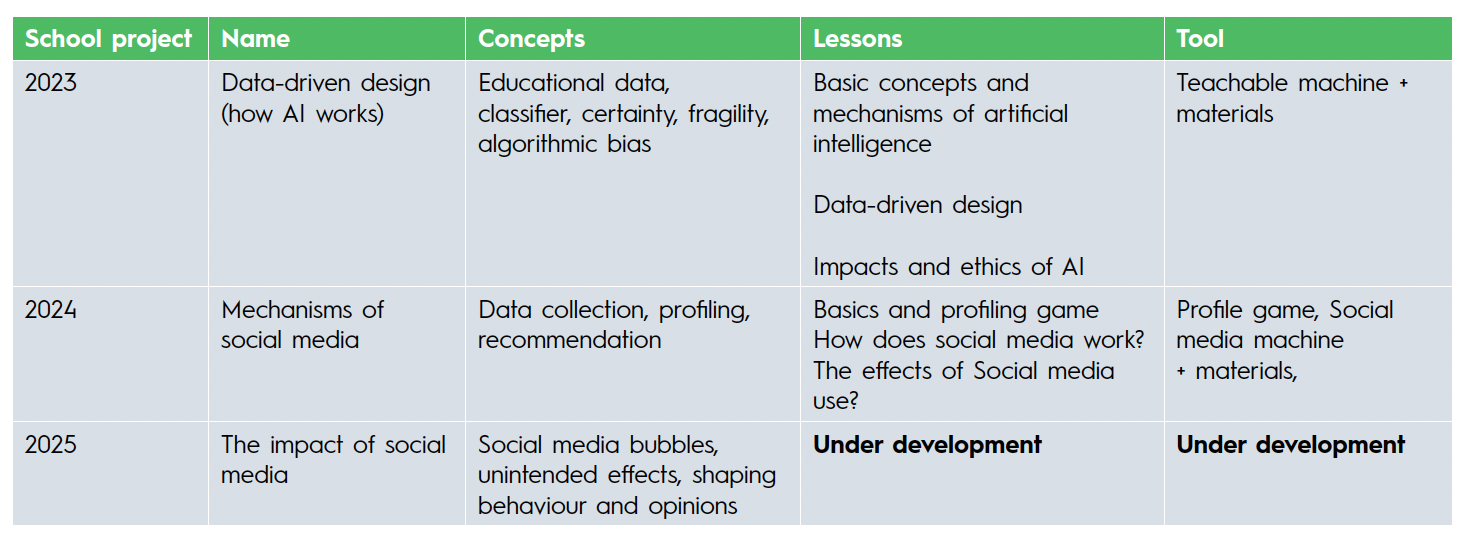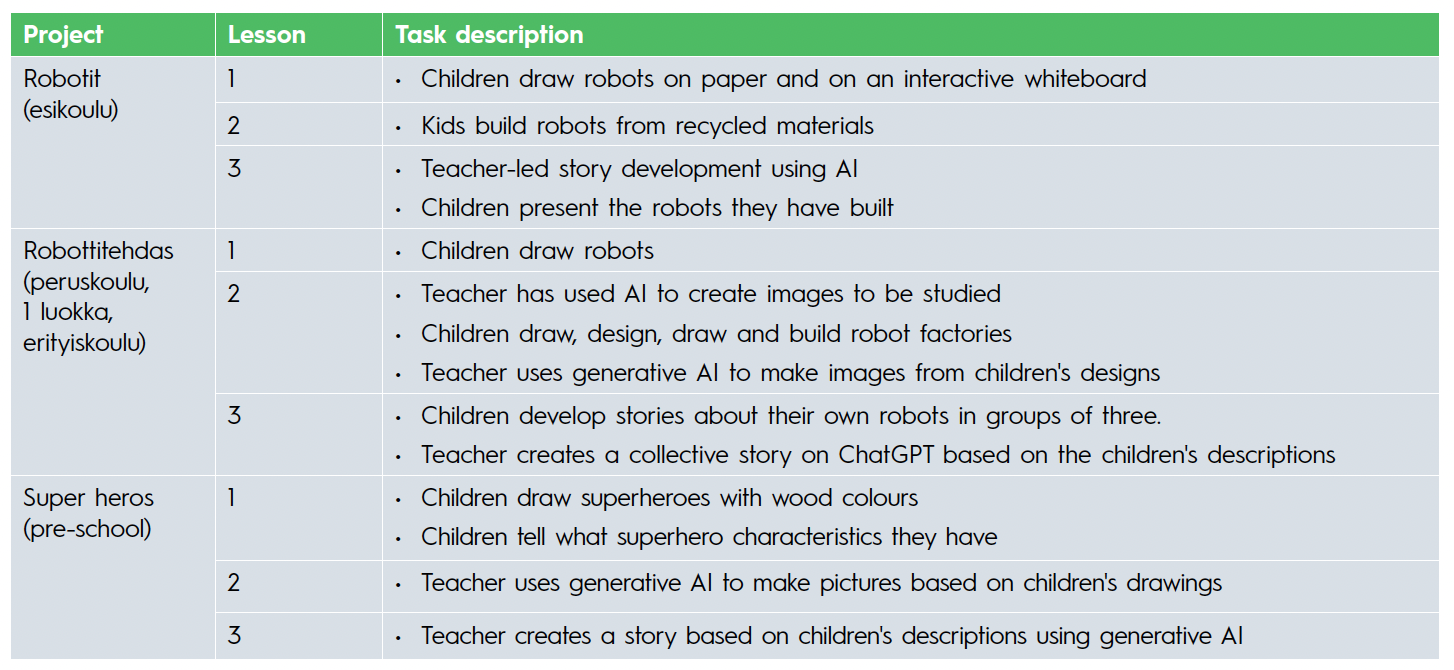Generation AI is a project funded by the Strategic Research Council (STN) of the Academy of Finland.
The overall aim of the Generation AI project is to support children and young people in understanding AI and machine learning technologies. It also aims to help them critically and ethically examine the different backgrounds, uses and impacts of AI-based technologies. Another important starting point is to support children’s creative capacities and their growth as informed and responsible actors for the future. The aim is for pupils to have meaningful experiences of success and to feel empowered to make a difference to the things they care about.
In short, the Generation AI project is exploring how to teach children about the mechanisms of AI, how AI works. At the same time, we are developing the foundations of AI and safety education.
We will develop applications to support AI education that are safe, accessible and free.
We will develop applications that are all safe, responsive and accessible. We will not collect data or track you. The legal experts working on our project have ensured that our apps comply with EU data protection requirements. In addition, our apps will be free and released under an MIT licence.
Teachable machine
AI applications have a strong presence in our everyday lives. We encounter them on social media, in innovative text and image generators, or even when we unlock our phones using facial recognition. But few of us think about how AI works, how AI applications are developed, and why AI sometimes makes mistakes.
Teachable machine is a tool that allows students to learn how AI works by building simple machine vision applications based on classification. It allows students to work through the entire machine learning workflow, from collecting data to deploying a mobile app as part of their work, without any programming skills. The chosen approach reduces the need for technical skills, making AI learning more inclusive [i].
The app is suitable for all ages and has been specifically designed with children and young people in mind. The teachable machine illustrates the potential of AI in a concrete way, introduces the underlying concepts and also leads to reflection on the limitations and ethical issues of AI.
Social media machine - social media simulator
The social media machine is an explainable artificial intelligence (XAI) tool designed for primary school students. It provides a familiar, interactive interface that matches students’ experiences on popular social media platforms, while offering ways to “peek under the hood” and reveal how “instagram works”. The aim is to teach key data-driven and AI-based social media mechanisms and core concepts such as data collection, profiling and recommendation in an accessible and engaging way. The aim is also to develop students’ understanding of data literacy, AI literacy and AI ethics [ii].
Through the social media machine, students will gain first-hand experience of how even the smallest actions, such as stopping content viewing, are recorded in their digital footprint and further in their personal profile. The social media machine uses real-time visualisations that allow users to see how their actions and those of others affect their social media experience [iii].
The social media machine learning materials and more detailed user manuals were published in the 2025 EDUCA event and are now available on the project website.
- Social media machine
- The source code of the social media machine
- Social media machine teaching materials
Involving children, young people and teachers as active participants and developing applications and materials together
Generation AI organises an annual participatory co-design project (school project) for participating schools (schools in Joensuu and Oulu), which includes age-appropriate, hands-on activities and interdisciplinary research together with teachers and students. The project is designed so that the same children and young people participate in three school projects (see Table 1) in successive years, introducing basic concepts and skills and addressing the social implications of everyday life. As part of the joint design, learning materials [iv] and tools [v] will also be developed to become national capital for every teacher and pupil in our country.
The first school project was carried out in 2023 and included data-driven design. It involved school students designing machine learning-based classifier applications using a teaching machine developed in the project [vi]. In practice, the students participated in three workshops on the basic concepts and mechanisms of AI, data-driven design and the impact and ethics of AI [vii].
The second school project in 2024 dealt with social media mechanisms, which were studied in two different lessons. In the first lesson, we studied data collection, profiling and recommendation using a machine learning exercise and a profiling game. In the second lesson, the social media machine simulator [viii] was used to study how social media mechanisms actually work. Materials related to this were published in January of 2025! Similarly, the planning for the third school project is just starting, so more information will be available later.

School projects 2023–2025
How to use AI creatively - towards the ability to use AI creatively and responsibly
Epistemic doubt - this rather awkward-sounding term has been the starting point for thinking about how we can learn to live, be, work and learn in this world of AI technologies. With the advent of generative AI, each of us has some doubts about the reliability of the content produced by AI. Total distrust prevents us from working with AI technologies, so it is a kind of balancing act [ix].
Pre-primary and primary education
In the context of pre-primary and primary education, research to date has looked at what can be done with AI and how content can be integrated into the pre-primary curriculum. This has led to projects such as Robotics, Robot Factory and Superhero, all of which have used generative AI as part of the pre-primary curriculum. AI has been used for storytelling, image-making and questioning, among other things.

Example tasks for pre-primary and primary education
From the above projects, researchers have identified different metaphors related to AI used by children and teachers: a) what AI is: computer (program); human (assistant); fantasy (magician); b) how AI works: computer (commands); human (intelligence, action); comparing human and technology; comparing natural and digital world; comparing fantasy and human action; b) existence of AI: doubt/belief; reassurance.
Basic education
In the context of basic education, various projects related to the use of generative AI have been carried out together with students in basic education, including projects related to luxury art and the internet, media and marketing.
The table below describes an example task in which the 6th grade students were asked to create advertisements for the advertising campaign “Helsinki, the summer city of youth”. In this fictional project, the 6th grade students used a soma machine to create different youth profiles and then were tasked with using generative AI to create targeted marketing materials for young people.

Stages of the Helsinki, Summer City of Youth advertising campaign
Our applications and materials will take into account children’s digital rights, as we will provide information on children’s digital rights and EU regulation.
In addition to developing tools, methods and teaching materials, the Generation AI project provides Finnish teachers and education providers with information on national legislation and EU regulations. These include, for example, data protection and AI regulation. Professor Susanna Lindroos-Hovinheimo has published several articles on the EU AI Regulation, including a short introduction to the EU AI Regulation published in the Yearbook of Communication Law last year [x].
Digital environments are often not designed with children or children’s rights in mind, but the tools have wide-ranging implications for children’s rights. There is also a clear tension identified between, for example, the need to protect children and children’s autonomy. For example, how can we protect children from risks, but at the same time enable children to access digital applications in the school environment? On this topic, Lakimies magazine [xi] published an openly available research article in Finnish , which has already received well-deserved attention, e.g. from education and training providers.
Teachers and other adults have a key role to play in ensuring children’s rights and their practical implementation - it is not enough to talk about them only at the top. The classroom and everyday school life is a particularly crucial context for the realisation of children’s digital rights. The Generation AI Privacy Guide [xii] , published on the project’s website, can help.
Summary
The applications, methods, materials and guides developed in Generation Ai are based on peer-reviewed and high quality international scientific research. We will build on this to develop the basis for AI and safety education in our country.
There is a strong demand for this project, as e.g. research on children’s rights is scarce in the context of AI and pedagogical models for research-based teaching of AI and data literacy are scarce.
We are developing solutions that are rare even on an international level, so you, the Finnish teacher, are privileged!
Follow our journey and join us!
Read the entire AI Guide for Teachers here.
Sources
[i] Pope, N., Vartiainen, H., Kahila, J., Laru, J. & Tedre, M. (2024a). A no code AI education tool for learning AI in K-12 by making machine learning-driven apps. 2024 IEEE International Conference on Advanced Learning Technologies (ICALT).
[ii] Pope, N., Vartiainen, H., Kahila, J., Laru, J. & Tedre, M. (2024b).An educational tool for learning about social media tracking, profiling, and recommendation. 2024 IEEE International Conference on Advanced Learning Technologies (ICALT).
[iii] Pope, N., Vartiainen, H., Kahila, J., Laru, J. & Tedre, M. (2024b).An educational tool for learning about social media tracking, profiling, and recommendation. 2024 IEEE International Conference on Advanced Learning Technologies (ICALT).
[iv] Kahila, J., Vartiainen, H., Tedre, M., Laru, J., Arkko, E., Lin, A., Pope, N. & Jormanainen, I. (2024a). Tekoäly oppimisen kohteena ja luovan toiminna lähteenä. Valkoinen kirja. January Collective. https://www.generation-ai-stn.fi/kirjasto/opetettavakone/mika-on-opetettava-kone/opetettava-kone-ja-materiaalit-perustuvat-tutkimukseen/
Kahila, J., Vartiainen, H., Tedre, M., Arkko, E., Lin, A., Pope, N., Jormanainen, I. & Valtonen, T. (2024b). Pedagogical framework for cultivating children’s data agency and creative abilities in the age of AI. Informatics in Education. doi:10.15388/infedu.2024.15
[v] Pope, N., Vartiainen, H., Kahila, J., Laru, J. & Tedre, M. (2024a). A no code AI education tool for learning AI in K-12 by making machine learning-driven apps. 2024 IEEE International Conference on Advanced Learning Technologies (ICALT).Pope, N., Vartiainen, H., Kahila, J., Laru, J. & Tedre, M. (2024b).An educational tool for learning about social media tracking, profiling, and recommendation. 2024 IEEE International Conference on Advanced Learning Technologies (ICALT).
[vi] Pope, N., Vartiainen, H., Kahila, J., Laru, J. & Tedre, M. (2024a). A no code AI education tool for learning AI in K-12 by making machine learning-driven apps. 2024 IEEE International Conference on Advanced Learning Technologies (ICALT).
[vii] [vii] Kahila, J., Vartiainen, H., Tedre, M., Laru, J., Arkko, E., Lin, A., Pope, N. & Jormanainen, I. (2024a). Tekoäly oppimisen kohteena ja luovan toiminna lähteenä. Valkoinen kirja. January Collective. https://www.generation-ai-stn.fi/kirjasto/opetettavakone/mika-on-opetettava-kone/opetettava-kone-ja-materiaalit-perustuvat-tutkimukseen/
Kahila, J., Vartiainen, H., Tedre, M., Arkko, E., Lin, A., Pope, N., Jormanainen, I. & Valtonen, T. (2024b). Pedagogical framework for cultivating children’s data agency and creative abilities in the age of AI. Informatics in Education. <doi:10.15388/infedu.2024.15>
[viii] Pope, N., Vartiainen, H., Kahila, J., Laru, J. & Tedre, M. (2024b).An educational tool for learning about social media tracking, profiling, and recommendation. 2024 IEEE International Conference on Advanced Learning Technologies (ICALT).
[ix] Davies, S., Sormunen, K., & Kangas, K. (2024). Cultivating Epistemic Doubt: a Key Competence for Productive Participation in the Era of Artificial Intelligence.17th International Conference on Computer-Supported Collaborative Learning (CSCL) 2024 - Buffalo, Yhdysvallat (USA)
[x] Lindroos-Hovinheimo, S. (2023). Lyhyt johdatus Unionin tekoälyasetukseen. In Viestintäoikeuden vuosikirja 2023 (pp. 67-76). Forum Iuris, Helsingin yliopisto Oikeustieteellinen tiedekunta. https://www.edilex.fi/viestintaoikeuden-vuosikirja/1000880004
[xi] Silvennoinen, E., Tedre, M., & Valtonen, T. (2024). Datafikoituva peruskoulu–tasapainoilua lapsen henkilötietojen suojan ja opetuksen tavoitteiden välillä. Lakimies, 122(5), 655-678.
[xii] Generation AI Tietosuojaopas (Haettu 18.12.2024) https://www.generation-ai-stn.fi/henkilotietojen-kasittely-alakoulussa/
Read the entire AI Guide for Teachers here.

